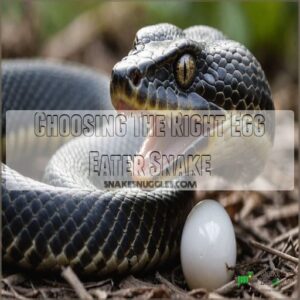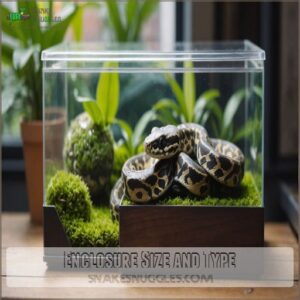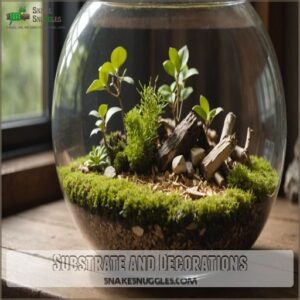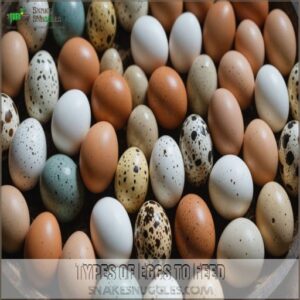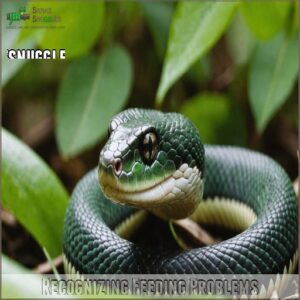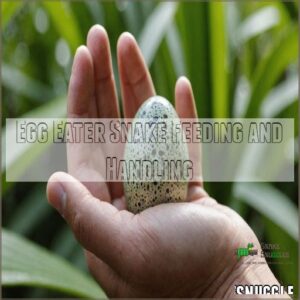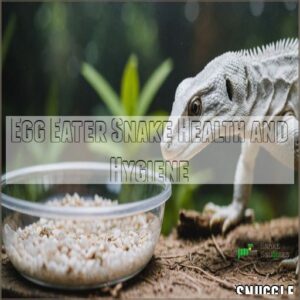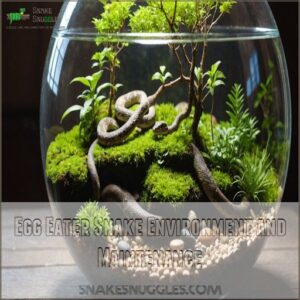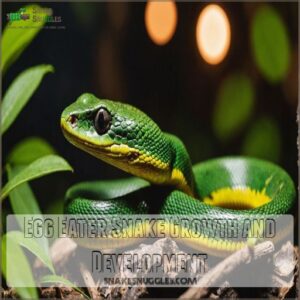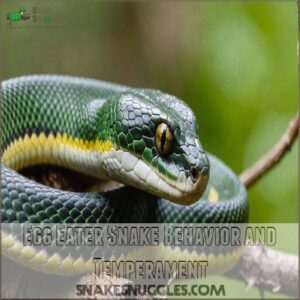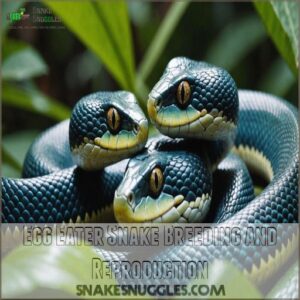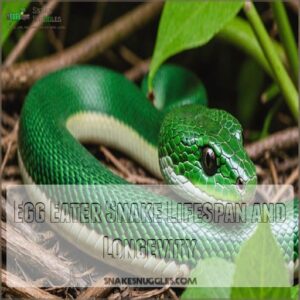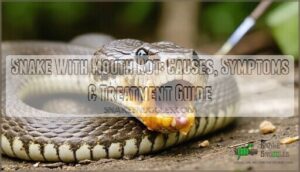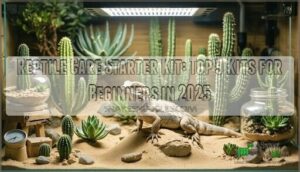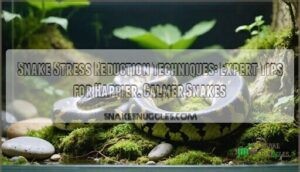This site is supported by our readers. We may earn a commission, at no cost to you, if you purchase through links.
 To keep your egg-eater snake thriving, picture its enclosure as a cozy studio with just the right amenities—20-30 gallons of space, good ventilation, and temperature control like a mini spa.
To keep your egg-eater snake thriving, picture its enclosure as a cozy studio with just the right amenities—20-30 gallons of space, good ventilation, and temperature control like a mini spa.
Its diet? Fresh bird eggs, carefully selected for a balanced menu.
This snake doesn’t bite—it can’t, really!—so handling is more about creating comfort.
Keep an eye on humidity levels and cleanliness to prevent health hiccups.
Regular feedings help avoid frustration (yours and the snake’s).
By understanding its quirks and needs, you’ll enjoy a snake that’s as content as a bookworm in a library.
Want tricks to mastering snake care. Choosing the right species, such as Corn Snakes or Ball Pythons for beginners, is essential for a happy and healthy pet. Want tricks to mastering snake care? Read on!
Table Of Contents
- Key Takeaways
- Choosing The Right Egg Eater Snake
- Egg Eater Snake Habitat and Setup
- Egg Eater Snake Diet and Nutrition
- Egg Eater Snake Feeding and Handling
- Egg Eater Snake Health and Hygiene
- Egg Eater Snake Environment and Maintenance
- Egg Eater Snake Growth and Development
- Egg Eater Snake Behavior and Temperament
- Egg Eater Snake Breeding and Reproduction
- Egg Eater Snake Lifespan and Longevity
- Frequently Asked Questions (FAQs)
- Do egg-eating snakes eat eggs?
- Are egg-eating snakes difficult to care for?
- What is an egg-eating snake?
- How to care for African egg-eating snakes?
- How do wild African egg-eating snakes eat?
- Should I rehome an egg eater snake?
- How to care for egg-eating snakes?
- Can you have an egg-eater snake as a pet?
- Do egg-eating snakes need a heat lamp?
- How long are egg-eating snakes?
- How to ensure egg availability year-round?
- Can egg eater snakes coexist with other reptiles?
- What are signs of stress in egg eater snakes?
- How to create a naturalistic enclosure for egg eater snakes?
- What are common parasites affecting egg eater snakes?
- Conclusion
Key Takeaways
- Ensure your snake’s enclosure offers a cozy 20-gallon space with proper temperature control and ventilation for optimal health.
- Feed your snake fresh bird eggs weekly, paying attention to the right size and shell thickness to aid digestion.
- Handle your snake gently and regularly to build trust and reduce stress; patience and calmness are key.
- Maintain the habitat’s cleanliness, regularly checking humidity and substrate to prevent health issues.
Choosing The Right Egg Eater Snake
When choosing the right egg eater snake, consider the many different breeds and their temperaments to find one that matches your personality and experience.
Don’t rush the decision—it’s like finding a reptilian roommate that’ll steal your eggs but reward you with a fascinating companionship.
Researching Egg Eater Snake Breeds
When you’re on the hunt for the perfect egg eater snake, it’s like choosing a vibrant character from a novel.
Explore different species’ geographic distribution and learn about captive breeding programs.
Each species might’ve diet variations and specific housing requirements, so make sure you’ve got the space and supplies to keep your new friend comfortable and thriving.
Understanding Egg Eater Snake Temperament
African egg-eating snakes‘ temperament is generally docile, making them popular pets.
Their primary defense is hissing and rubbing their scales; rarely do they bite.
Gentle handling helps with socialization, reducing stress.
Early, consistent interaction builds trust and a calmer snake.
Remember, patience is key!
Considering Your Lifestyle and Experience
Thinking about egg eater snakes at home? Consider your own lifestyle and experience first. These snakes are cool but need care:
- Time Commitment: Can you manage regular feedings with bird eggs and maintenance?
- Space Requirements: Do you have enough room for a 20-gallon tank?
- Handling Comfort: Comfortable with regular handling? They’ll need it!
Egg Eater Snake Habitat and Setup
Creating the perfect home for your egg-eating snake is like designing a cozy apartment they’ll love.
Start with the right size enclosure.
Heat and light it properly.
Add some decor they’ll enjoy exploring.
Enclosure Size and Type
Choosing the right egg eater snake sets the stage for their new home sweet home. Tank size matters, so aim for a 20-gallon setup.
Think about enclosure ventilation—no one wants a stuffy home.
Add a suitable substrate for comfort, a hide box for privacy, and a water dish for hydration.
Here’s a quick checklist:
| Feature | Size/Type | Purpose |
|---|---|---|
| Tank Size | 20 gallons | Space to roam |
| Enclosure Ventilation | Front-facing door | Fresh air |
| Substrate | Aspen shavings | Cozy bedding |
Heating and Lighting Requirements
Creating a comfy home for your egg eater snake involves mastering heating sources like basking lamps.
A thermal gradient of 70 to 90 degrees Fahrenheit makes your snake happy, and you need to choose the right bulb wattage based on terrarium size to maintain this temperature range.
Let your reptile bask in the gentle glow, but remember—temperatures shouldn’t drop below 60 degrees.
Keep tabs on this cozy setup with monitoring, and adhere to a consistent light cycle.
Humidity and Water Needs
Balancing humidity levels is like sweet-talking your snake to a comfy life. Keep humidity around 40-60%. Place a shallow water bowl for hydration, but not too shallow or your snake might think it’s a hot tub. A good misting frequency, maybe once a week, keeps the mood just right. Remember, avoid making it a rainforest!
- Humidity levels: 40-60%
- Water source: shallow bowl
- Misting frequency: weekly
- Water bowl size: not too deep
Substrate and Decorations
The right substrate type is key for your egg eater snake’s comfort.
Opt for aspen shavings or bark: they’re natural materials that mimic the wild.
Spruce up the enclosure aesthetics with DIY decorations like rocks and branches.
Don’t skimp on hiding spots; they’re essential for a snake’s peace.
Combining practicality with creativity creates a happy habitat.
Egg Eater Snake Diet and Nutrition
Your egg-eating snake’s diet is surprisingly specific; they only eat bird eggs!
We’ll cover what types of eggs are best, how often to feed your slithery friend, and how to spot any potential feeding problems.
Types of Eggs to Feed
Picking eggs for your snake is like choosing the right paintbrush for an artist. You’ll want to think about a few key factors:
- Egg size: Smaller eggs suit younger snakes.
- Shell thickness: Thin shells are easier to swallow.
- Egg availability: Choose what you can find easily.
- Nutritional value: Go for a mix of quail and finch eggs for dietary variety.
Feeding Frequency and Quantity
When you’re feeding your egg eater snake, think about its age, egg size, and metabolism.
Younger snakes have speedier metabolisms and might eat tiny eggs weekly, while older ones can stretch meals to every 10 days.
Remember that egg-eating snakes have unique adaptations, such as specialized vertebrae, that allow them to consume eggs efficiently.
Adjust the feeding schedule based on their appetite and growth.
Remember, they know if an egg’s overcooked—or, you know, fertilized!
Recognizing Feeding Problems
Ever had that moment when your egg eater refuses its meal?
Don’t panic!
Check if the egg size is right—too big might be the issue.
Try shell scraping to entice them if appetite loss persists.
Occasional regurgitation happens, but keep an eye on it.
Adjust feeding frequency gradually, ensuring they’re comfortable and willing to eat.
Providing a Balanced Diet
Getting your egg eater snake’s diet just right involves a bit of variety.
Offer eggs from different birds to keep it interesting and nutritious.
Sometimes, they might need a little help with calcium supplements for stronger shells.
Keep a steady feeding schedule to prevent vitamin deficiencies.
Shell removal can aid digestion, ensuring your snake stays happy and healthy.
Egg Eater Snake Feeding and Handling
Regarding feeding your egg eater snake, make sure to offer them tasty bird eggs that are the right size for their slender jaws, and remember that patience is key if they decide to be a bit picky.
Handling these snakes can be a breeze; just be gentle and give them time to get comfy with you, keeping their tiny tempers in check with lots of calm and care.
Safety Precautions for Handling
After figuring out their diet, let’s focus on safety while handling your egg eater snake.
Always support the snake’s body, stay calm, and avoid sudden movements.
Watch for signs of stress, like hissing, to prevent biting.
Keep your hands sanitized to avoid transferring bacteria.
Make sure the enclosure is safe by closely watching the snake’s behavior during and after handling.
Getting Your Snake Used to Handling
Introduce your egg-eater to handling gradually.
Short, supervised sessions are key.
You can even find egg eater snake hide online, which can help your snake feel more secure.
Watch for stress signals like hissing or trying to escape.
Positive reinforcement, like gentle petting when calm, works wonders.
Remember, patience is key to building trust.
Your snake will learn to associate you with positive experiences.
Soon, those handling sessions will become enjoyable for both of you!
Handling Techniques and Best Practices
Mastering safe handling of your egg eater snake involves a gentle approach to build trust.
Observe snake behavior closely—start with minimal handling and increase gradually, always supporting its body.
Avoid disturbing it during post-feeding care to reduce stress.
Think of it like coaxing a shy friend at a party, patience and kindness winning their confidence.
Dealing With Biting and Aggression
Feeling nibbly from your egg eater?
Sometimes these slithery pals can show aggression out of stress or fear.
Understanding their triggers helps curb bites.
Check these tips:
- Keep handling to short, consistent sessions.
- Use gentle movements and calm voices.
- Recognize stress signs like hissing.
- Avoid handling post-meal.
Stay patient, and you’ll see improvement!
Egg Eater Snake Health and Hygiene
Keeping your egg eater snake healthy involves ensuring a balanced diet with adequate calcium and vitamin D3, which can be achieved by choosing the right snake food for picky eaters. Keeping your egg eater snake healthy involves spotting common health issues early and maintaining proper hygiene.
Regular cleaning and attentive care prevent illnesses, making life easier for you and your scaly friend—just think of it as less time scrubbing and more time sharing eggcellent company!
Common Health Issues
Handling your egg eater snake is thrilling, but watch for common health hiccups.
Respiratory infections can sneak in with wrong temperatures; keep them just right.
If shedding problems arise, boost humidity.
Egg regurgitation‘s normal—like returning a bought, but wrong-sized egg!
Lack of appetite? Try smaller, warmer eggs.
Parasites are pesky, so maintain a clean setup for a happy, healthy snake.
Recognizing Signs of Illness
Spotting a sick egg eater snake isn’t rocket science. Look for lethargy, appetite loss, or shedding issues; these often mean trouble.
Check for signs your snake is unwell, such as skin changes, eye issues, or abnormal body posture like those described in common snake health issues.
Respiratory problems like wheezing or bubbles from the nostrils require attention.
Watch for abnormal behavior; it might be nothing, but it’s best to check.
Trust your intuition—when your scaly friend acts off, it’s better to investigate early.
Proper Hygiene and Cleaning
Keep your egg eater snake‘s home clean for its health and comfort.
Regularly remove fecal matter and replace the substrate to prevent parasites.
Clean water bowls for hygiene and avoid bacterial growth.
Consistently check enclosure sanitation to make sure a tidy environment.
A little prevention with these tasks saves a lot of trouble when it comes to their well-being!
Quarantine and Isolation Procedures
Your new snake’s arrival calls for quarantine! This important step protects your existing pets from potential diseases.
- Isolate your new snake in a separate enclosure for at least 30 days.
- Closely monitor your snake for any signs of illness or parasites.
- Regular health checks are key to early disease prevention.
This minimizes stress and maximizes your snake’s chances of a long, healthy life.
Egg Eater Snake Environment and Maintenance
Keeping an egg eater snake happy requires a clean and well-maintained environment, with regular tasks on your to-do list.
Don’t worry, staying on top of these duties isn’t hard, and your slithery friend will thank you with many healthy years.
Daily and Weekly Tasks
Caring for your snake is a breeze with a weekly checklist.
Clean the enclosure, change water, and check the feeding schedule.
Don’t forget the substrate check and hide box maintenance—your snake’s little hideaway deserves love too!
With a sprinkle of attention, your snake will thrive, curbing any reptilian rebellion.
| Task | Frequency |
|---|---|
| Enclosure Cleaning | Weekly |
| Water Change | Weekly |
| Feeding Schedule | Weekly |
| Substrate Check | Weekly |
Monthly and Quarterly Tasks
Each month, focus on these four key tasks to keep your egg eater snake’s environment comfy and clean:
- Enclosure cleaning: Remove old substrate and wipe down surfaces.
- Substrate refresh: Lay down fresh, snake-safe bedding.
- Water change: To prevent bacterial and parasite growth, learn about proper snake hydration tips(snake hydration tips). Make sure your snake’s water bowl is fresh and clean.
- Hide box check: Inspect and clean its favorite hideouts.
Annual Tasks and Check-Ups
Got the routine down pat? Now, think about your egg eater snake’s yearly checkup!
Schedule a vet visit for an overall health review.
A good clean habitat does wonders, so swap out that substrate, check the lighting, and give that water bowl a good scrub.
A little annual enclosure maintenance can keep your snake slithering smoothly and happily.
Troubleshooting Common Issues
Troubleshooting common issues with your egg eater snake can be challenging, but don’t fret. Handle them like a pro:
Building a custom enclosure can be challenging, but having access to over 9,000 woodworking plans at Furniture Woodworking Plans can make a huge difference.
- Shedding Problems: Increase humidity or offer a warm soak.
- Egg Regurgitation: Make sure eggs are warm and fresh.
- Appetite Loss: Double-check egg size and temperature.
- Respiratory Issues: Adjust tank humidity and temperature to prevent sneezes and wheezes.
You’ll have a healthier snake in no time!
Egg Eater Snake Growth and Development
Caring for your egg eater snake means understanding their species’ unique characteristics, such as the fact that Dasypeltis snakes thrive on a diet of quail eggs and basking temperatures around 90°F. Caring for your egg eater snake’s growth and development means understanding their unique growth rates and keeping an eye on their weight and health.
By providing a stimulating environment, you make sure they’ve everything they need to thrive as they mature.
Understanding Growth Rates
Keeping tabs on your egg eater’s growth is key!
They don’t grow at a steady pace; it’s more like bursts of growth followed by slower periods.
Here’s a helpful guide:
| Age (Months) | Length (inches) | Weight (grams) | Feeding Frequency | Notes |
|---|---|---|---|---|
| 1-3 | 6-8 | 10-20 | Weekly | Rapid growth |
| 4-6 | 10-12 | 25-40 | Every 10 days | Growth slows |
| 7-9 | 14-16 | 50-70 | Every 2 weeks | Steady growth |
| 10-12 | 18-20 | 80-100 | Every 2-3 weeks | Near adult size |
| Adult | 20-24 | 100-150 | Every 3 weeks | Mature size |
Remember, these are estimates.
Your snake’s unique journey matters most!
Factors Affecting Growth and Development
As you think about growth rates, remember that several factors shape your egg eater’s development.
First, temperature and humidity create the backdrop for healthy growth.
Second, nutrition plays a starring role; proper eggs provide ample energy.
Monitoring Weight and Health
Tracking your snake’s weight isn’t just for competitive bodybuilders; it’s key for gauging health.
Regular weigh-ins reveal growth patterns, while keeping a feeding log helps spot any appetite changes.
Keep an eye on shedding cycles, as irregularities could signal health concerns.
Think of it as your snake’s personal health diary, spotlighting issues before they escalate.
Providing a Stimulating Environment
So, you’ve nailed monitoring your egg eater snake’s weight and health.
Now, let’s spark some excitement by creating a stimulating environment.
Add enrichment with hides, climbing branches, and even toys.
Here are three ways:
- Rotate decor weekly.
- Introduce new scents with safe plants.
- Interactive feeding keeps the mind sharp.
Your snake will thank you!
Egg Eater Snake Behavior and Temperament
To truly enjoy the company of your egg eater snake, you’ll want to understand its natural behaviors and temperament.
These snakes are generally calm and docile, but recognizing signs of stress or fear will help you keep them comfortable and happy.
Understanding Natural Behavior
You’ve marveled at their growth, now let’s peek into their daily lives.
These egg-eating snakes are specialists, adapting unique skills to devour their eggy feasts.
They hiss using keel scales as a neat defensive trick.
Watch them burrow and detect prey like secretive ninjas.
Though mostly solitary, their social interactions are rare and curious moments to observe.
Recognizing Signs of Stress or Fear
Spotting a stressed egg eater snake involves watching its body language.
If it’s constantly hiding, hissing, or trembling, something’s amiss.
A sudden drop in appetite? That’s a red flag too!
Remember, snakes can’t spill their secrets, but they show them.
Here’s what to watch for:
- Hiding excessively
- Frequent hissing
- Involuntary trembling
- Decreased appetite
- Closed body posture
Encouraging Calm Behavior
Recognizing stress in your egg eater is the first step.
A stressed snake might hide more or move less.
Gentle handling, using proper techniques, helps reduce stress.
A calm, predictable environment is key.
Positive reinforcement, like offering a favorite egg after a calm handling session, works wonders.
Regular, short interactions promote socialization and build trust.
Remember, patience is your best friend!
Dealing With Aggression
Handling aggression in egg-eater snakes can feel like defusing a tiny, scaly bomb.
Stress triggers such as sudden movements or handling too soon after feeding might be the culprits.
Try desensitization methods by gently handling your snake regularly.
Be patient, and remember, a calm environment and proper handling techniques are your best allies in bite prevention.
Egg Eater Snake Breeding and Reproduction
Breeding egg eater snakes can be a rewarding challenge, needing just the right environment to guarantee success.
You’ll get to witness their fascinating reproductive cycle, from courtship to the arrival of tiny hatchlings, making every step a unique adventure.
Understanding Reproductive Cycles
Understanding the reproductive cycles of egg eater snakes is key to ensuring their well-being.
This includes a pre-breeding period of up to 12 weeks for some species, as outlined in this snake breeding guide.
During breeding season, males perform unique mating rituals to woo females.
It’s important to monitor the female’s health, especially her appetite and weight, throughout this period.
After successful mating, pay attention to the incubation period, as it’s essential for healthy hatchling development.
Breeding Techniques and Best Practices
When setting up breeding pairs for egg eater snakes, consider their temperament and make sure genetic diversity for healthy offspring.
An engaging factor for your snakes could be introducing them in a stress-free, spacious environment.
Approach breeding with ethical considerations, making sure you’re ready for hatchling care.
Remember, creating the right incubation setup is key to success.
Egg Laying and Incubation
Imagine this: you’ve got your egg eater snake ready for reproduction magic.
First, make sure the egg size is manageable for incubation, utilizing a reliable Egg Eater Snake Incubator Egg Eater Snake Incubator for the best results.
Next, provide soft nesting materials that mimic their natural habitat.
Finally, patience is golden as you wait for hatching success.
Remember, eggs don’t need parental care, so relax and enjoy the fascinating process unfolding right before you!
Raising Hatchlings
Once those adorable eggs have hatched, it’s time to keep your new hatchlings healthy and happy.
Start with a cozy, smaller enclosure to match their tiny size.
Feed them appropriately sized eggs, making sure not to overfeed.
Handle them gently to build trust.
Watch for any health issues—quick action keeps them on a smooth road to growth and development!
Egg Eater Snake Lifespan and Longevity
Want to know how long your egg-eating snake might live? With proper care, these fascinating reptiles can enjoy a lifespan of 10-20 years, though several factors influence their longevity.
Average Lifespan in Captivity
Breeding’s wrap-up naturally leads us to lifespan.
Egg eater snakes in captivity can live 10 to 15 years if conditions are right.
Think of it as providing them a spa retreat—ideal captive diet, stable health checks, and snug enclosures create a cozy home.
It’s like owning a tiny dragon, minus the fiery breath!
Factors Affecting Lifespan
An egg eater snake’s lifespan is often shaped by various factors. Pay attention to their diet, maintain a stress-free environment, and make sure proper husbandry is in place.
- Genetics: Some just have better starting lineups.
- Diet: Balanced meals equal long life.
- Stress: Noise and rough handling shorten lives.
- Environment: Keep temperatures just right.
- Husbandry: Cleanliness avoids disease.
Providing a Long and Healthy Life
To ensure a long, healthy life for your egg-eating snake, understanding the average lifespan of pet snakes is important, as domesticated snakes can live for 10 to 30 years on average.
Provide a stress-free environment by keeping noise and disturbances to a minimum.
Make regular veterinary visits a priority to catch health issues early.
Make sure proper hydration and a diet of balanced nutrition.
Keep a consistent routine for feeding and care; your snake will appreciate the predictability!
End of Life Care
As your egg eater snake ages, recognizing signs of decline helps in making thoughtful decisions.
Consider euthanasia options if necessary, aiming for the least distress.
The emotional impact can be tough, so plan funeral arrangements or memorial ideas to honor your pet.
It’s a soothing gesture, like giving a last gentle embrace to a cherished friend.
Frequently Asked Questions (FAQs)
Do egg-eating snakes eat eggs?
Yes, you’ll find that egg-eating snakes, like the aptly named African egg-eater, have a diet that exclusively consists of bird eggs. They’re specialists, you see!
Are egg-eating snakes difficult to care for?
Caring for egg-eating snakes isn’t too tricky with the right setup.
Make sure you have a suitable tank, proper temperature, and fresh bird eggs.
They’re pretty docile, but handling gently helps them feel at home—like having breakfast in bed!
What is an egg-eating snake?
Egg-eating snakes, like Dasypeltis scabra, thrive on bird eggs.
These non-venomous reptiles hail from Africa and the Middle East.
They’re known for their gentle nature and unique method of swallowing eggs whole, like tiny oval-shaped surprises.
How to care for African egg-eating snakes?
Start by setting up a 20-gallon tank with good ventilation.
Maintain temperatures between 70-90°F.
Feed bird eggs weekly, ensuring they’re fresh.
Handle gently, support their body, and keep the humidity balanced for healthy shedding.
How do wild African egg-eating snakes eat?
In the wild, African egg-eating snakes carefully locate bird nests to feast on eggs.
Their flexible jaws allow them to swallow eggs whole.
Special spines in their throats crack the eggshells, letting them digest the contents easily.
Should I rehome an egg eater snake?
Rehoming your egg-eating snake? It’s a big choice!
Consider factors like time, resources, and your snake’s well-being.
If you’re feeling overwhelmed, finding a new home experienced with reptiles might be best for both of you.
How to care for egg-eating snakes?
African egg-eating snakes thrive in a 20-gallon tank with a warm side of 90°F.
These non-venomous snakes eat bird eggs weekly.
They appreciate substrate bedding.
African egg-eating snakes require gentle handling post-meal to stay healthy and happy.
Can you have an egg-eater snake as a pet?
Yes, you can! These docile snakes make unique pets, but require specialized care. Their egg-only diet needs planning, and proper housing is essential for their well-being.
Do egg-eating snakes need a heat lamp?
Surprisingly, egg-eating snakes thrive at a cozy 70°F.
While a heat lamp isn’t mandatory, to keep your egg eater snake warm, snakes like them require a specific temperature gradient for optimal health, such as a basking spot and a cooler area, which can be achieved by creating an effective heat gradient. Keeping a warm side at 90°F with a basking lamp or heating pad helps your snake stay active and comfortable.
How long are egg-eating snakes?
Egg-eating snakes typically reach lengths of 24 to 30 inches.
They’re not the longest in the snake world, but their unique appetite for eggs makes them stand out!
Perfect for someone who appreciates quirky reptile pets.
How to ensure egg availability year-round?
Keeping your snake fed year-round might feel like finding a needle in a haystack, but partnering with local bird breeders or farmers guarantees fresh eggs.
Store fertilized eggs at room temperature for best nutrition.
Can egg eater snakes coexist with other reptiles?
African egg-eating snakes are best kept alone due to their specialized diet.
They can be stressed by other reptiles, so maintain peace by giving them their own space.
Their egg-only diet makes cohabitation tricky anyway!
What are signs of stress in egg eater snakes?
You might notice signs of stress in your egg-eating snake if it hisses, rubs its scales together, seeks constant hiding, or refuses to eat.
Make sure its environment is comfortable to help reduce anxiety.
How to create a naturalistic enclosure for egg eater snakes?
Replicate their natural habitat!
Use branches, rocks, and leaf litter.
A shallow water dish is a must.
Maintain proper temperature and humidity gradients.
Observe your snake’s behavior to perfect the setup.
What are common parasites affecting egg eater snakes?
Common parasites affecting egg-eating snakes include mites, ticks, and internal worms like roundworms.
Keep an eye out for symptoms like lethargy, abnormal shedding, or loss of appetite.
Regular vet check-ups and maintaining clean habitats help prevent infestations.
Conclusion
Did you know that egg eater snakes can live up to 10 years with proper care?
Keeping your egg eater snake content is like crafting a perfect recipe—balance its environment, feeding, and handling just right.
Tending to its unique diet of carefully selected bird eggs, while making sure a comfy, well-maintained habitat, similar to a proper boa constrictor enclosure setup, keeps these snakes happy and healthy.
Consistent handling builds trust, and staying alert to health signals makes sure a joyful life for both you and your snake.

